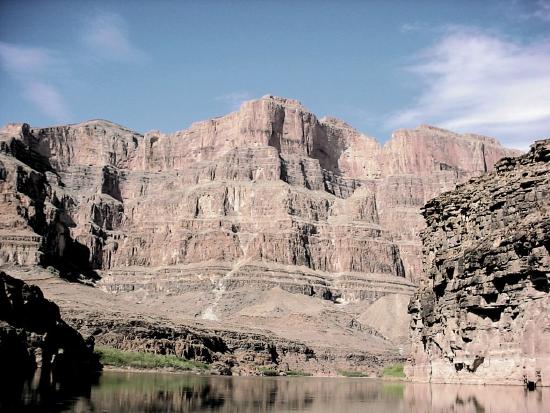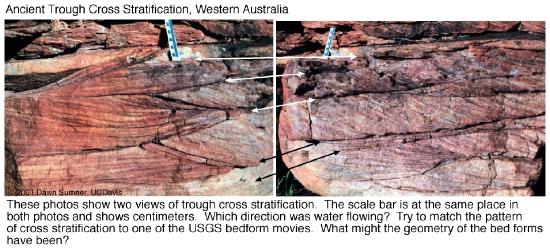1.4: 4. Bedforms
- Page ID
- 1385
\( \newcommand{\vecs}[1]{\overset { \scriptstyle \rightharpoonup} {\mathbf{#1}} } \)
\( \newcommand{\vecd}[1]{\overset{-\!-\!\rightharpoonup}{\vphantom{a}\smash {#1}}} \)
\( \newcommand{\id}{\mathrm{id}}\) \( \newcommand{\Span}{\mathrm{span}}\)
( \newcommand{\kernel}{\mathrm{null}\,}\) \( \newcommand{\range}{\mathrm{range}\,}\)
\( \newcommand{\RealPart}{\mathrm{Re}}\) \( \newcommand{\ImaginaryPart}{\mathrm{Im}}\)
\( \newcommand{\Argument}{\mathrm{Arg}}\) \( \newcommand{\norm}[1]{\| #1 \|}\)
\( \newcommand{\inner}[2]{\langle #1, #2 \rangle}\)
\( \newcommand{\Span}{\mathrm{span}}\)
\( \newcommand{\id}{\mathrm{id}}\)
\( \newcommand{\Span}{\mathrm{span}}\)
\( \newcommand{\kernel}{\mathrm{null}\,}\)
\( \newcommand{\range}{\mathrm{range}\,}\)
\( \newcommand{\RealPart}{\mathrm{Re}}\)
\( \newcommand{\ImaginaryPart}{\mathrm{Im}}\)
\( \newcommand{\Argument}{\mathrm{Arg}}\)
\( \newcommand{\norm}[1]{\| #1 \|}\)
\( \newcommand{\inner}[2]{\langle #1, #2 \rangle}\)
\( \newcommand{\Span}{\mathrm{span}}\) \( \newcommand{\AA}{\unicode[.8,0]{x212B}}\)
\( \newcommand{\vectorA}[1]{\vec{#1}} % arrow\)
\( \newcommand{\vectorAt}[1]{\vec{\text{#1}}} % arrow\)
\( \newcommand{\vectorB}[1]{\overset { \scriptstyle \rightharpoonup} {\mathbf{#1}} } \)
\( \newcommand{\vectorC}[1]{\textbf{#1}} \)
\( \newcommand{\vectorD}[1]{\overrightarrow{#1}} \)
\( \newcommand{\vectorDt}[1]{\overrightarrow{\text{#1}}} \)
\( \newcommand{\vectE}[1]{\overset{-\!-\!\rightharpoonup}{\vphantom{a}\smash{\mathbf {#1}}}} \)
\( \newcommand{\vecs}[1]{\overset { \scriptstyle \rightharpoonup} {\mathbf{#1}} } \)
\( \newcommand{\vecd}[1]{\overset{-\!-\!\rightharpoonup}{\vphantom{a}\smash {#1}}} \)
\(\newcommand{\avec}{\mathbf a}\) \(\newcommand{\bvec}{\mathbf b}\) \(\newcommand{\cvec}{\mathbf c}\) \(\newcommand{\dvec}{\mathbf d}\) \(\newcommand{\dtil}{\widetilde{\mathbf d}}\) \(\newcommand{\evec}{\mathbf e}\) \(\newcommand{\fvec}{\mathbf f}\) \(\newcommand{\nvec}{\mathbf n}\) \(\newcommand{\pvec}{\mathbf p}\) \(\newcommand{\qvec}{\mathbf q}\) \(\newcommand{\svec}{\mathbf s}\) \(\newcommand{\tvec}{\mathbf t}\) \(\newcommand{\uvec}{\mathbf u}\) \(\newcommand{\vvec}{\mathbf v}\) \(\newcommand{\wvec}{\mathbf w}\) \(\newcommand{\xvec}{\mathbf x}\) \(\newcommand{\yvec}{\mathbf y}\) \(\newcommand{\zvec}{\mathbf z}\) \(\newcommand{\rvec}{\mathbf r}\) \(\newcommand{\mvec}{\mathbf m}\) \(\newcommand{\zerovec}{\mathbf 0}\) \(\newcommand{\onevec}{\mathbf 1}\) \(\newcommand{\real}{\mathbb R}\) \(\newcommand{\twovec}[2]{\left[\begin{array}{r}#1 \\ #2 \end{array}\right]}\) \(\newcommand{\ctwovec}[2]{\left[\begin{array}{c}#1 \\ #2 \end{array}\right]}\) \(\newcommand{\threevec}[3]{\left[\begin{array}{r}#1 \\ #2 \\ #3 \end{array}\right]}\) \(\newcommand{\cthreevec}[3]{\left[\begin{array}{c}#1 \\ #2 \\ #3 \end{array}\right]}\) \(\newcommand{\fourvec}[4]{\left[\begin{array}{r}#1 \\ #2 \\ #3 \\ #4 \end{array}\right]}\) \(\newcommand{\cfourvec}[4]{\left[\begin{array}{c}#1 \\ #2 \\ #3 \\ #4 \end{array}\right]}\) \(\newcommand{\fivevec}[5]{\left[\begin{array}{r}#1 \\ #2 \\ #3 \\ #4 \\ #5 \\ \end{array}\right]}\) \(\newcommand{\cfivevec}[5]{\left[\begin{array}{c}#1 \\ #2 \\ #3 \\ #4 \\ #5 \\ \end{array}\right]}\) \(\newcommand{\mattwo}[4]{\left[\begin{array}{rr}#1 \amp #2 \\ #3 \amp #4 \\ \end{array}\right]}\) \(\newcommand{\laspan}[1]{\text{Span}\{#1\}}\) \(\newcommand{\bcal}{\cal B}\) \(\newcommand{\ccal}{\cal C}\) \(\newcommand{\scal}{\cal S}\) \(\newcommand{\wcal}{\cal W}\) \(\newcommand{\ecal}{\cal E}\) \(\newcommand{\coords}[2]{\left\{#1\right\}_{#2}}\) \(\newcommand{\gray}[1]{\color{gray}{#1}}\) \(\newcommand{\lgray}[1]{\color{lightgray}{#1}}\) \(\newcommand{\rank}{\operatorname{rank}}\) \(\newcommand{\row}{\text{Row}}\) \(\newcommand{\col}{\text{Col}}\) \(\renewcommand{\row}{\text{Row}}\) \(\newcommand{\nul}{\text{Nul}}\) \(\newcommand{\var}{\text{Var}}\) \(\newcommand{\corr}{\text{corr}}\) \(\newcommand{\len}[1]{\left|#1\right|}\) \(\newcommand{\bbar}{\overline{\bvec}}\) \(\newcommand{\bhat}{\widehat{\bvec}}\) \(\newcommand{\bperp}{\bvec^\perp}\) \(\newcommand{\xhat}{\widehat{\xvec}}\) \(\newcommand{\vhat}{\widehat{\vvec}}\) \(\newcommand{\uhat}{\widehat{\uvec}}\) \(\newcommand{\what}{\widehat{\wvec}}\) \(\newcommand{\Sighat}{\widehat{\Sigma}}\) \(\newcommand{\lt}{<}\) \(\newcommand{\gt}{>}\) \(\newcommand{\amp}{&}\) \(\definecolor{fillinmathshade}{gray}{0.9}\)A Few Definitions:
1) "Stratification" - layers in rocks; stratified rocks are those organized into beds
2) “Beds” are separated by “bedding planes” - cm to m thick units of sedimentary rock that were deposited approximately horizontally (beds) and are separated by approximately horizontal planes (bedding planes); the rocks typically weather more along these planes. Beds are usually fairly uniform or change gradationally in composition. Bedding planes usually represent breaks in sedimentation or changes in grain size. In other words, they usually represent changes in flow characteristics.
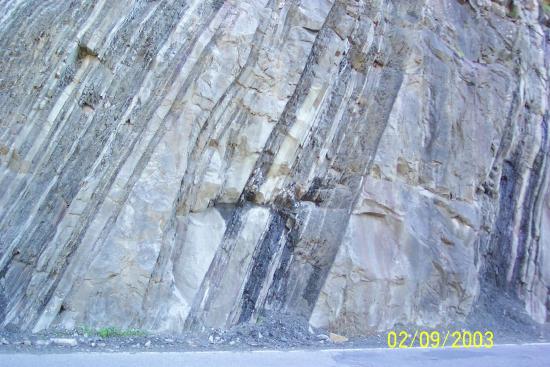 Cache Creek Turbidite Beds and Bedding Planes. They were originally deposited about horizontally and were tilted due to tectonic activity.
Cache Creek Turbidite Beds and Bedding Planes. They were originally deposited about horizontally and were tilted due to tectonic activity.
3) "Laminae" are color, composition, or grain size variations defining surfaces within a bed. They typically represent variations in flow velocity, sediment supply, sediment composition, etc. Planar Laminae are parallel to bedding, e.g. planar and deposited approximately horizontally.
4) "Cross Lamination”, "Cross Stratification" or "Cross Bedding" are laminations or layers that are oriented obliquely to bedding. They truncate older laminae and are truncated by younger laminae. The erosional surfaces that separate “sets” of similarly oriented laminae are called “bounding surfaces”. There are lots of subdivisions of cross stratification; different types represent different types of bedforms and different flow conditions.
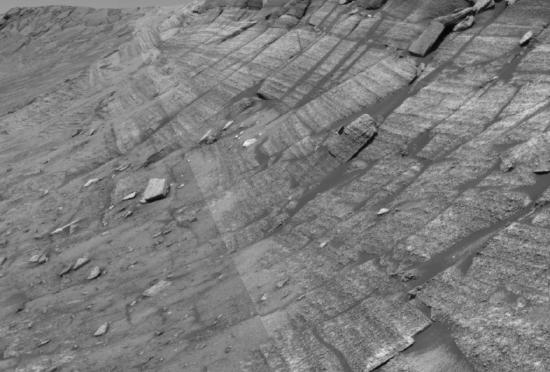 Burns Cliff on Mars photographed by the rover Opportunity: The upper part of the image has planar lamination, and the lower part to the far left has cross lamination or stratification. (The very straight line running diagonally from top to bottom is a seam where two images were merged together.)
Burns Cliff on Mars photographed by the rover Opportunity: The upper part of the image has planar lamination, and the lower part to the far left has cross lamination or stratification. (The very straight line running diagonally from top to bottom is a seam where two images were merged together.)
Other examples of dune cross stratification can be found here.
See ripple cross lamination on Mars
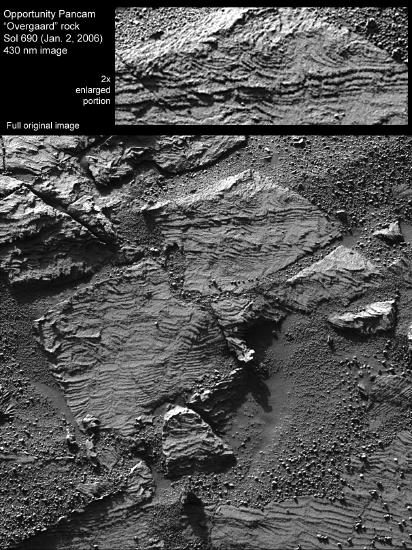
Bedforms
When sediments get deposited from turbulent flows, the sediment interacts with the geometry of the flow. Depending on the flow speed, turbulence, and sediment characteristics, different structures or bedforms develop.
Bed Geometry and Flow Separation
Until now, we have been implicitly assuming that the bases of beds are flat and smooth, but if sediment is present, they are not. If you start with a smooth bed of sand and increase water speed above it, irregularities form from irregularities in the flow. Irregularities in sand develop into ripples if the flow speed is appropriate. First, a few grains pile up. Once the height of the pile is several grains high, there is a flow shadow down stream of them, and the laminar sublayer detaches from the base of the flow. The water has enough momentum that it does not hug the bed surface and instead, goes shooting out over the top. This point is called the separation point. The water flows forward and downward and reconnects with the bed at the attachment point. At the attachment point, water is flowing directly towards the sediment with a lot of force. This force moves the grains and causes erosion. In contrast, the area between the separation point and the attachment point has a very low flow speed. In fact, there can be back eddies, where the flow is moving upstream. Thus, sediment transport is very irregular along the bedding surface at a local scale.
Sediment Transport Over a Ripple
Sediment grains are mobilized at the attachment point - more so than in normal flow because the water is shooting directly into the sediment - and the grains are moved downstream by saltation and traction. As the flow becomes parallel to the sediment surface again, its ability to transport sediment decreases. Thus, the grains tend to pile up and a new mound forms. This gives a periodic chain of mounds - the beginnings of ripples. As flow continues, grains roll and saltate up the stoss (upcurrent) side of the ripples. Once they pass the crest, they reach the low flow on the lee side of the ripple. The larger grains settle out and roll partway down the slope; this is the site of net deposition. As the process of deposition on the lee side and erosion on the stoss side continues, the ripples migrate downstream. If there is net deposition of sediment, the ripples leave behind distinctive dipping layers between two erosional surfaces that can be preserved in the rock record. These layers slope downstream and are one type of cross lamination.
 A sketch of a ripple or dune like the one in lecture
A sketch of a ripple or dune like the one in lecture
Watch the USGS bedform movies described at: Sedimentary Structures Lab and Homework Resources
Bedforms and Flow Velocity
The size and shape of subaqueous bedforms depends on flow strength and grain size and can be used to interpret ancient flow characteristics in a depositional environment from looking at sedimentary rocks. See Nichols (2009, Sedimentology and Stratigraphy, section 4.3) for bedform, flow speed, and grain size relationships.
Ripples
(crest-to-crest distance - or wavelength - of less than 50 cm and heights of less than 4 cm)
The minimum flow for ripples is determined by the minimum velocity for sediment transport. Once this flow speed is reached, ripples form if the sediment is transported as bedload. The maximum flow speed for ripples depends on the location of the attachment point on the stoss side of the ripples. As flow gets faster, too much erosion occurs at the crests of the ripples - the point of attachment is too far up the stoss side of the ripple- and the ripples flatten out. Dunes develop.
Dunes
(60 cm-100’s m wavelength and 10’s of cm to meters in height)
Dunes develop as ripples flatten out because large scale irregularities start to develop. The basic ideas of dune and ripple formation are the same. The difference is that the area of flow separation is much larger (see Fig 4.17, Nichols 2009). Roller vortexes (e.g. upstream flows along the lee sides of dunes) are common, and the upstream flow can be strong enough to form ripples that migrate upstream. As flow speeds increase, the dunes start to flatten out.
Planar/Flat Lamination
Planar lamination forms when the flow is strong enough that the beds flatten out. The momentum of the transported grains and fluid are high enough that they tend to move horizontally, eroding any irregularities in the bed. This zone of planar lamination is called “upper flow regime”. (Why “upper”? - there is a zone of planar lamination in coarse grained sediment at low flow velocities.)
Antidunes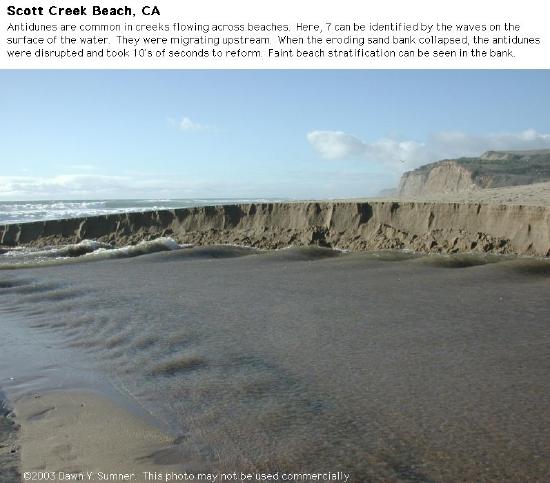
Antidunes form at flow speeds greater than planar lamination when shallow water moves very quickly (Putah Creek in flood; tidal channels; creeks flowing across beaches). Irregularities form on the planar beds, but there is no flow separation. Instead, the water surface mimics the bedding surface. On the down flow side of the antidunes, there is a very strong erosional force (from the Bernoulli Effect) and sediment gets plastered onto the upstream side. Thus, antidunes produce laminae that dip upstream, and they migrate upstream (anti normal dune behavior). Sediment is still transported downstream; it is just the peak of the dune itself that moves upstream. At even higher flow, the waves on the surface of the water break, and the dunes become very irregular. Antidunes are rarely preserved in the rock record because they are reworked into other sedimentary structures as the flow speed decreases.
Other Types of Flows
Not all flows are uniform in one direction. For example, waves move water back and forth, transporting sand back and forth. Because the transport direction varies through time, the orientation of cross laminations vary through time. Compare the ripple types at http://mygeologypage.ucdavis.edu/sumner/gel109/sedstructures/ARipples.html. Note that wave ripple lamination dips in two directions and the ripple crests are symmetric rather than steeper on the lee slope than the stoss slope. Flows can also be irregular due to combinations of currents and waves, etc. Some of these flows are very characteristic of specific environments, for example, storm-influenced beaches. The structures they produce are very useful for interpreting ancient rocks, and we will highlight them as we discuss different sedimentary environments.
Bedforms and Grain Size
Bedforms also vary with grain size (see Figure 4.20, Nichols, 2009). Very fine sand and silt are very easy to transport and erode. They form nice ripples, but do not form dunes when transported by water. Instead, ripples transition into planar laminae. Coarse sand and larger sediment is too hard to transport and erode to get ripples. The erosional force at the reattachment point is not strong enough to erode the coarse grains and produce the erosional surfaces on the backs of ripples. Without this erosion, troughs do not form and without troughs, crests do not form. The sequence of structures in granules with increasing flow is:
- no transport
- faint planar lamination - the lamination is poorly developed because the sediment is often poorly sorted and not much transport is occurring
- dunes - the flow is strong enough to erode at the attachment point
- upper planar lamination
- antidunes
In contrast, the sequence of structures in silt is:
- no transport
- ripples
- upper planar lamination
- antidunes
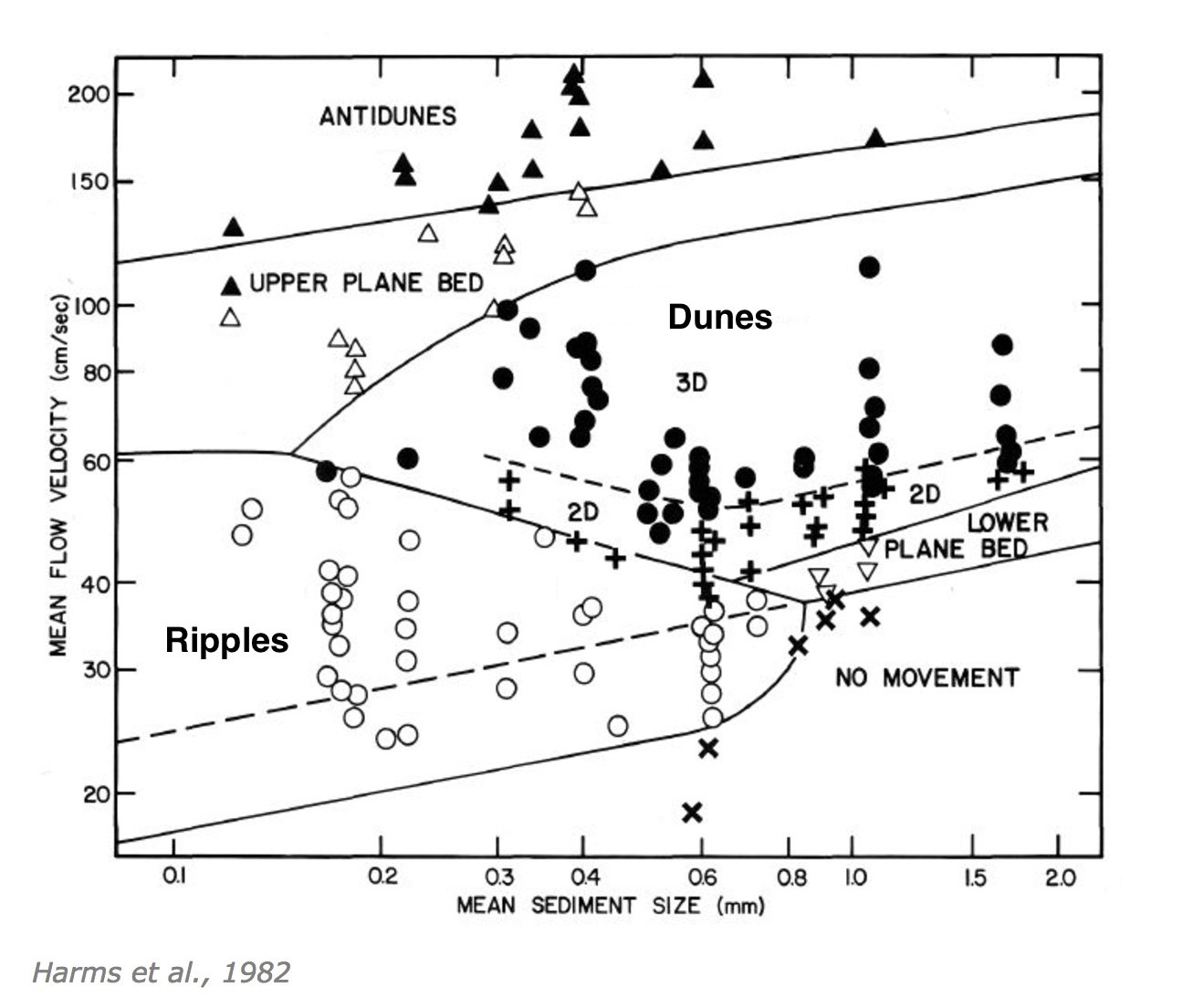
Extra: High Sediment Loads
Sometimes with slope failures on land or under water, much more sediment can be put into motion than the flow would normally erode. Depending on the amount of water mixed with the sediment, the flow characteristics are different. When abundant water is present, the sediment can form a thick slurry with a higher density than sediment-free water, commonly leading to a higher Re and more turbulent flow (Re=u*l*r/µ). Also, collisions between grains become extremely important. Both of these tend to keep the sediment moving. Grain-to-grain collisions also have an important effect on grain sorting. The collisions tend to make sorting much less efficient and the sediment that gets deposited tends to consist of which ever grains make it to the base of the flow and are not kicked back up again. Usually, the largest grains are part of this first deposit because they weigh more, but small grains are also present. As the amount of sediment decreases, the flow becomes more like typical water flows. Turbidites are subaqueous flows that start out with a very high sediment load and decrease in time to more normal flows. They have characteristic sedimentary structures associated with them that reflect these changes.
If there is very little water associated with a clay-rich sediment flow, the flow can be very viscous due to the charge attraction among clay particles. The high viscocity makes the flow laminar (Re=u*l*r/µ). Debris flows with lots of cohesive mud are like this. In laminar flows, there is no mixing of the water or grains (or ice) and there is no sorting of grain sizes. Thus, the sediment remains mixed up with large grains, sometimes boulders, “floating” in mud. They flow down hill pulled by gravity until the flow seizes up and stops. This can be due to too low a slope or loss of water. Underwater debris flows can also be diluted by water that gets incorporated at the edges of the flow and become less viscous and more turbulent.
There also are dry sediment flows in which air is present between grains. For example, rock avalanches and some pyroclastic flows from volcanoes lack water. For these to move significant distances, large amounts of energy from either gravity or explosions are necessary to keep the sediment in motion.



